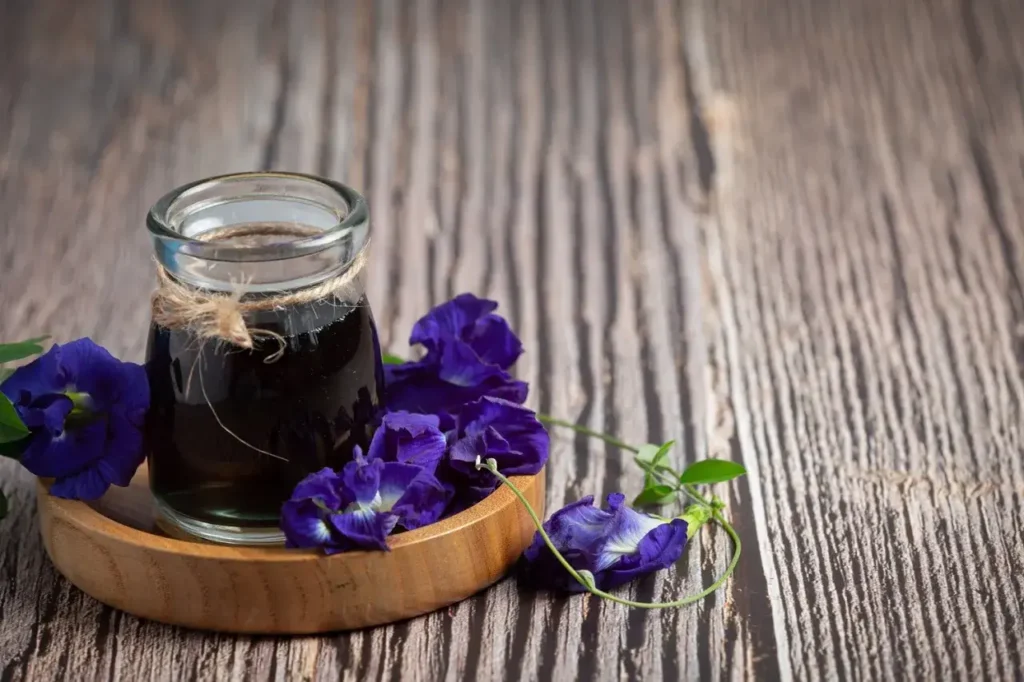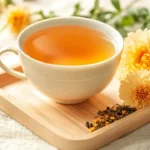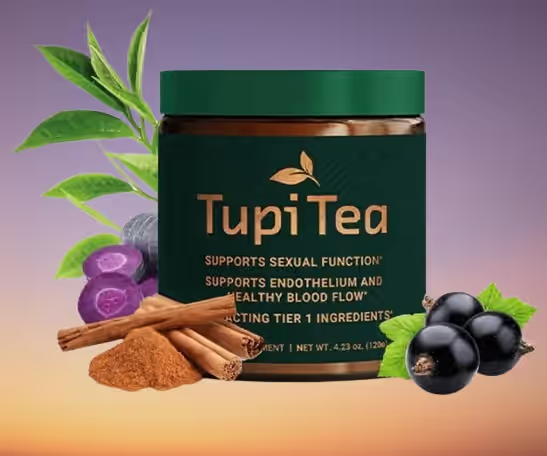Table of Contents
Introduction
Butterfly pea flower tea, known for its vibrant blue hue and numerous health benefits, has gained popularity in recent years. It’s often praised for its antioxidant properties, cognitive enhancement, and calming effects. However, like most natural remedies, it’s essential to understand the potential side effects. While it is generally considered safe, overconsumption or allergic reactions can lead to unexpected issues. In this article, we’ll dive into five surprising butterfly pea flower tea side effects, explore its taste profile, and discuss the trendy butterfly pea flower tea lemonade.
What is Butterfly Pea Flower Tea?
Butterfly pea flower tea is derived from the dried petals of the Clitoria ternatea plant, native to Southeast Asia. Traditionally used in Ayurvedic medicine, it’s now popular worldwide for its unique color-changing properties. When brewed, the tea is a deep, vibrant blue, which can change to purple or pink when acidity is introduced, like with a squeeze of lemon. This has made it a social media sensation, particularly in beverages like butterfly pea flower tea lemonade.
The Nutritional Profile of Butterfly Pea Flower Tea
When it comes to exploring new and beneficial beverages, butterfly pea flower tea stands out as a vibrant choice with a remarkable nutritional profile. This captivating blue tea is not just visually appealing but also packed with numerous health benefits that make it a worthy addition to your daily routine.
One of the standout features of butterfly pea flower tea is its rich antioxidant content. Antioxidants are crucial for combating oxidative stress in the body, which can lead to chronic diseases and aging. The presence of anthocyanins, which give the tea its striking blue color, plays a significant role in providing these antioxidants. By incorporating this tea into your diet, you can support your body’s natural defense systems and promote overall well-being.
Moreover, the nutritional value of butterfly pea flower tea extends beyond its antioxidant properties. It is known to support brain health by enhancing cognitive function and reducing anxiety levels. The calming effects are attributed to compounds that increase levels of neurotransmitters associated with mood regulation.
In addition to mental health benefits, this herbal infusion aids in digestion and has been linked to improved skin health due to its anti-inflammatory properties. With such an impressive array of advantages, it’s easy to see why butterfly pea flower nutrition has captured the attention of health enthusiasts worldwide.
Incorporating butterfly pea flower tea into your daily regimen not only adds a splash of color but also delivers substantial health benefits that make it a compelling choice for those seeking both flavor and wellness in their beverage selection.
👉 Elevate Your Tea Game with Top-Quality Butterfly Pea Flower Tea – Click Here! 👈
Butterfly Pea Flower Tea Side Effects
While butterfly pea flower tea is generally safe for most people, there are some potential side effects and considerations to be aware of.
1. Digestive Issues
For some individuals, consuming butterfly pea flower tea in large amounts may lead to digestive problems. The plant contains anthocyanins, which are responsible for its rich color and antioxidant properties. While these compounds are beneficial in moderation, overconsumption could cause stomach upset, including nausea and diarrhea.
How to Prevent It:
- Limit your intake to one or two cups per day.
- If you have a sensitive stomach, start with a small amount to test your tolerance.
2. Allergic Reactions
Though rare, some people may experience allergic reactions to butterfly pea flower tea. Symptoms can include itching, hives, or swelling of the lips and throat. If you have a history of plant-based allergies, consult with your doctor before trying this tea.
How to Prevent It:
- Conduct a patch test before consuming the tea, especially if you have sensitive skin.
- Start with a small sip and monitor for any signs of an allergic reaction.

3. Interference with Blood Sugar Levels
Studies suggest that butterfly pea flower tea may lower blood sugar levels, which can be beneficial for some. However, for those already on medication for diabetes or hypoglycemia, this can cause complications. A significant drop in blood sugar can lead to dizziness, fatigue, or fainting.
How to Prevent It:
- If you’re diabetic or on any blood sugar medication, consult your healthcare provider before incorporating butterfly pea flower tea into your routine.
- Monitor your blood sugar levels closely if you decide to try the tea.
4. Possible Impact on Hormones
Butterfly pea flower tea contains certain phytoestrogens, which mimic estrogen in the body. While this is beneficial for some women, particularly those going through menopause, it could interfere with hormonal balance for others. Women who are pregnant, breastfeeding, or those with hormone-sensitive conditions should avoid excessive consumption of butterfly pea flower tea.
How to Prevent It:
- If you are pregnant, breastfeeding, or have a hormonal condition, speak with your healthcare provider before drinking this tea.
- Limit your intake to avoid potential hormonal disruption.
5. Diuretic Effect
Butterfly pea flower tea has mild diuretic properties, which means it promotes urine production. While this can help with detoxification and reducing bloating, it may lead to dehydration if consumed in large quantities. Additionally, individuals on diuretic medications should be cautious as this could amplify the effect and cause electrolyte imbalances.
How to Prevent It:
- Drink plenty of water alongside your tea to stay hydrated.
- If you’re on diuretics, limit your intake to avoid adverse effects.
What Does Butterfly Pea Flower Tea Taste Like?
Now that we’ve explored the side effects, let’s discuss the taste of butterfly pea flower tea. It has a mild, earthy flavor with subtle hints of green tea. Unlike other herbal teas that may be sweet or aromatic, butterfly pea flower tea is more neutral, making it a versatile base for various beverages. When consumed on its own, it may not be too flavorful, but its beauty lies in its compatibility with other ingredients.
For example, adding lemon or honey can enhance its flavor profile. Many people enjoy it cold, mixed with herbs, or as an iced tea for a refreshing drink. Additionally, butterfly pea flower tea can be incorporated into recipes like lattes, cocktails, and smoothies, providing both a striking visual and a neutral base that complements a wide range of flavors.
👉 Brew a Natural Blue & Purple Infusion – Shop Exclusive Butterfly Pea Tea Now! 👈
Butterfly Pea Flower Tea Lemonade: A Delicious Trend

One of the most popular ways to enjoy butterfly pea flower tea is in the form of lemonade. The color-changing magic that occurs when lemon juice is added makes it an Instagram-worthy beverage, perfect for parties or personal enjoyment. Butterfly pea flower tea lemonade combines the calming, earthy notes of the tea with the tangy sweetness of lemonade, creating a drink that’s both refreshing and visually stunning.
How to Make Butterfly Pea Flower Tea Lemonade:
Here’s a simple recipe to try at home:
Ingredients:
- 1 tablespoon dried butterfly pea flowers (or 1 tea bag)
- 1 cup hot water
- Juice of 1 lemon
- 1-2 tablespoons honey or sugar (optional, to taste)
- Ice cubes
- Mint leaves for garnish (optional)
Instructions:
- Brew the butterfly pea flower tea by steeping the flowers or tea bag in hot water for 5-7 minutes.
- Let the tea cool to room temperature, then pour it into a glass filled with ice.
- Add lemon juice and watch the tea turn from blue to purple or pink.
- Stir in honey or sugar to taste, and garnish with mint leaves.
- Serve and enjoy this beautiful and refreshing beverage!
This trendy drink is not only fun to look at but also provides the potential health benefits of butterfly pea flower tea, like antioxidants and anti-inflammatory properties, while masking any earthy undertones with the sweetness of lemonade.
Conclusion: Understanding the Risks of Butterfly Pea Tea
While butterfly pea flower tea offers a wide range of health benefits, it’s essential to be aware of its side effects. From digestive issues to possible allergic reactions and hormone impacts, knowing how to consume it safely is key. Always start in moderation and consult with a healthcare professional if you have any underlying conditions. For most people, butterfly pea flower tea is a delightful, versatile drink that can be enjoyed in various forms, from a calming hot beverage to the ever-popular butterfly pea flower tea lemonade.
With its striking color and mild flavor, it’s no surprise that this tea has gained widespread popularity. Whether you’re curious about its taste or the potential side effects, butterfly pea flower tea can be a valuable addition to your wellness routine when consumed responsibly.
👉 Discover the Top-Rated Butterfly Pea Flower Tea for Beauty & Wellness – Get Yours Now! 👈













